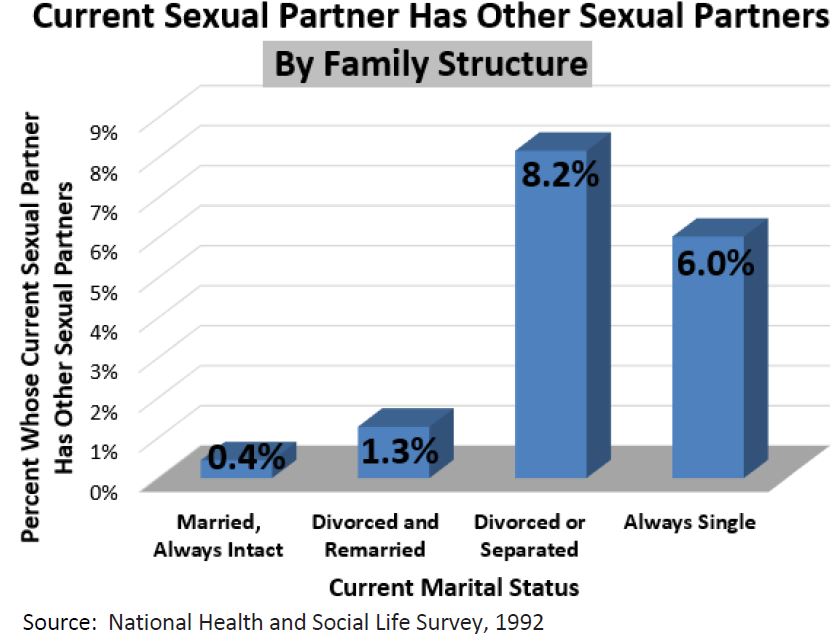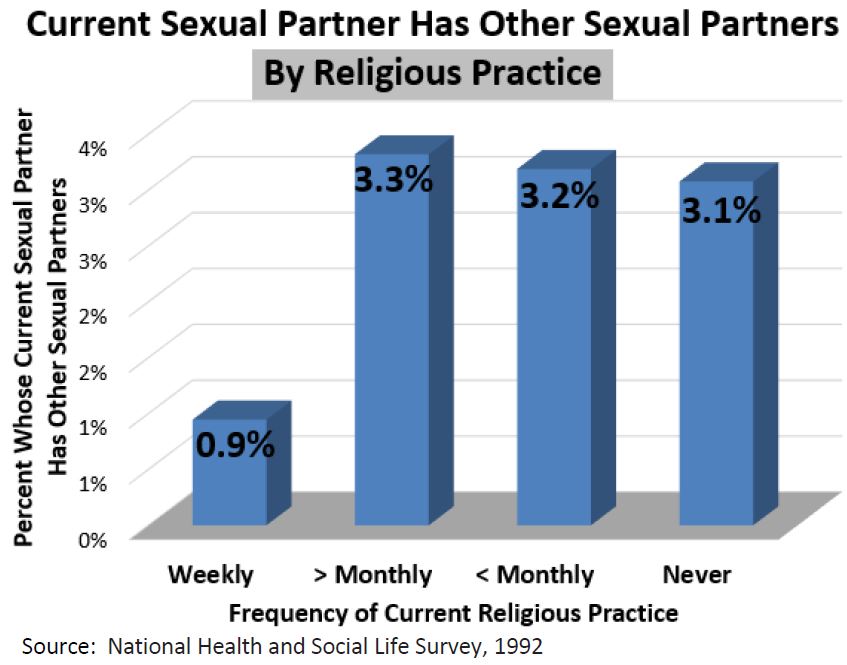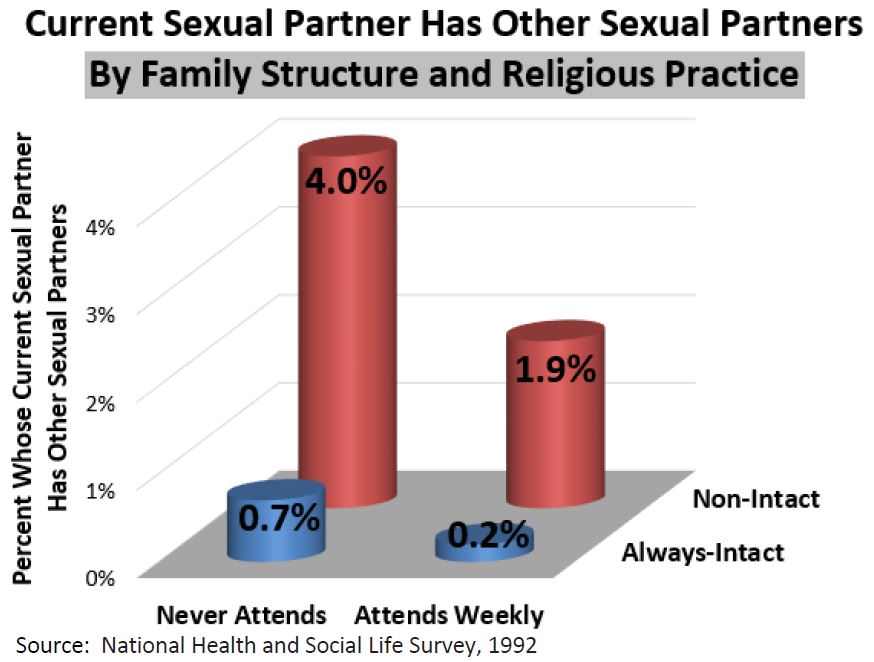Click Here to download “Current Sexual Partner Has Other Sexual Partners by Family Structure and Religious Practice”
Current Sexual Partner Has Other Sexual Partners by Family Structure and Religious Practice
Adults aged 18 to 59 in intact marriages who worshiped weekly were least likely to have a current sexual partner who had other concurrent sexual partners, according to the National Health and Social Life Survey (1992), the most detailed analysis of sexual behavior in America.
[1]
Family Structure: Those in always-intact marriages were least likely to have a current sexual partner who had other concurrent sexual partners (4 percent). This was more prevalent in non-intact family structures and among singles: 1.3 percent of those who were divorced or remarried had a sexual partner who had other concurrent sexual partners; 6 percent of those who were always single had a sexual partner who had other concurrent sexual partners; and 8.2 percent of those who were divorced or separated had a sexual partner who had other concurrent sexual partners.
 Religious Practice:
Religious Practice: Those who worshiped weekly were least likely to have a current sexual partner who had other concurrent sexual partners (.9 percent), followed by those who never worshiped (3.1 percent), those who worshiped less than monthly (3.2 percent), and those who worshiped less than weekly but at least monthly (3.3 percent).
 Family Structure and Religious Practice Combined:
Family Structure and Religious Practice Combined: Those in intact marriages who worshiped weekly were the least likely to have a current sexual partner who had other concurrent sexual partners (.2 percent), followed by those in intact marriages who never worshiped (.7 percent), those in non-intact family structures or who were single who worshiped weekly (1.9 percent), and those in non-intact family structures or who were single who never worshiped (4 percent).
 Related Insights from Other Studies:
Related Insights from Other Studies: A survey of 10,868 adolescent females from a state in the Midwest found that adolescents whose parents were involved in their lives, were aware of their child’s activities, and themselves disapproved of teenage sexual activity had fewer sexual partners than other adolescents.
[2]
Analysis of data on 8,450 males and females aged 14 to 22 from the 1992 Youth Risk Behavior Survey found a strong association between alcohol use and having multiple sexual partners. Logistic regression analyses showed that alcohol use and a younger age at first intercourse were associated with greater odds that male and female respondents had two or more partners in the three months prior to the survey.
[3]
[1] These charts draw on data collected by the 1992 National Health and Social Life Survey
[2] Tom Luster and Stephen A. Small, “Sexual Abuse History and Number of Sex Partners Among Female Adolescents,”
Journal of Family Planning Perspectives 29, no. 5 (October 1997): 204-211.
[3] John S. Santelli, Nancy D. Brener, Richard Lowry, Amita Bhatt and Laurie S. Zabin, “Multiple Sexual Partners Among U.S. Adolescents and Young Adults,”
Journal of Family Planning Perspectives 30, no. 6 (November/December 1998): 271-275.]]>
 Religious Practice: Those who worshiped weekly were least likely to have a current sexual partner who had other concurrent sexual partners (.9 percent), followed by those who never worshiped (3.1 percent), those who worshiped less than monthly (3.2 percent), and those who worshiped less than weekly but at least monthly (3.3 percent).
Religious Practice: Those who worshiped weekly were least likely to have a current sexual partner who had other concurrent sexual partners (.9 percent), followed by those who never worshiped (3.1 percent), those who worshiped less than monthly (3.2 percent), and those who worshiped less than weekly but at least monthly (3.3 percent).
 Family Structure and Religious Practice Combined: Those in intact marriages who worshiped weekly were the least likely to have a current sexual partner who had other concurrent sexual partners (.2 percent), followed by those in intact marriages who never worshiped (.7 percent), those in non-intact family structures or who were single who worshiped weekly (1.9 percent), and those in non-intact family structures or who were single who never worshiped (4 percent).
Family Structure and Religious Practice Combined: Those in intact marriages who worshiped weekly were the least likely to have a current sexual partner who had other concurrent sexual partners (.2 percent), followed by those in intact marriages who never worshiped (.7 percent), those in non-intact family structures or who were single who worshiped weekly (1.9 percent), and those in non-intact family structures or who were single who never worshiped (4 percent).
 Related Insights from Other Studies: A survey of 10,868 adolescent females from a state in the Midwest found that adolescents whose parents were involved in their lives, were aware of their child’s activities, and themselves disapproved of teenage sexual activity had fewer sexual partners than other adolescents.[2]
Analysis of data on 8,450 males and females aged 14 to 22 from the 1992 Youth Risk Behavior Survey found a strong association between alcohol use and having multiple sexual partners. Logistic regression analyses showed that alcohol use and a younger age at first intercourse were associated with greater odds that male and female respondents had two or more partners in the three months prior to the survey.[3]
[1] These charts draw on data collected by the 1992 National Health and Social Life Survey
[2] Tom Luster and Stephen A. Small, “Sexual Abuse History and Number of Sex Partners Among Female Adolescents,” Journal of Family Planning Perspectives 29, no. 5 (October 1997): 204-211.
[3] John S. Santelli, Nancy D. Brener, Richard Lowry, Amita Bhatt and Laurie S. Zabin, “Multiple Sexual Partners Among U.S. Adolescents and Young Adults,” Journal of Family Planning Perspectives 30, no. 6 (November/December 1998): 271-275.]]>
Related Insights from Other Studies: A survey of 10,868 adolescent females from a state in the Midwest found that adolescents whose parents were involved in their lives, were aware of their child’s activities, and themselves disapproved of teenage sexual activity had fewer sexual partners than other adolescents.[2]
Analysis of data on 8,450 males and females aged 14 to 22 from the 1992 Youth Risk Behavior Survey found a strong association between alcohol use and having multiple sexual partners. Logistic regression analyses showed that alcohol use and a younger age at first intercourse were associated with greater odds that male and female respondents had two or more partners in the three months prior to the survey.[3]
[1] These charts draw on data collected by the 1992 National Health and Social Life Survey
[2] Tom Luster and Stephen A. Small, “Sexual Abuse History and Number of Sex Partners Among Female Adolescents,” Journal of Family Planning Perspectives 29, no. 5 (October 1997): 204-211.
[3] John S. Santelli, Nancy D. Brener, Richard Lowry, Amita Bhatt and Laurie S. Zabin, “Multiple Sexual Partners Among U.S. Adolescents and Young Adults,” Journal of Family Planning Perspectives 30, no. 6 (November/December 1998): 271-275.]]>
